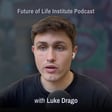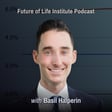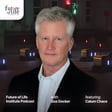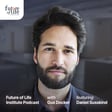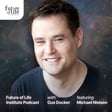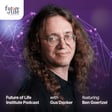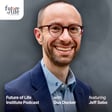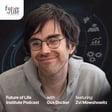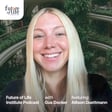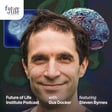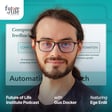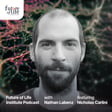Become a Creator today!Start creating today - Share your story with the world!
Start for free
00:00:00
00:00:01

Ann Pace on using Biobanking and Genomic Sequencing to Conserve Biodiversity
Ann Pace joins the podcast to discuss the work of Wise Ancestors. We explore how biobanking could help humanity recover from global catastrophes, how to conduct decentralized science, and how to collaborate with local communities on conservation efforts.
You can learn more about Ann's work here:
https://www.wiseancestors.org
Timestamps:
00:00 What is Wise Ancestors?
04:27 Recovering after catastrophes
11:40 Decentralized science
18:28 Upfront benefit-sharing
26:30 Local communities
32:44 Recreating optimal environments
38:57 Cross-cultural collaboration
Transcript
Introduction to Wise Ancestors and Their Mission
00:00:00
Speaker
Welcome to the Future of Life Institute podcast. My name is Gus Stocker and I'm here with Anne Pace from Wise Ancestors. Anne, welcome to the podcast. Thank you. Hello, Gus. A natural first question would be, what is Wise Ancestors?
00:00:16
Speaker
So Wise Ancestors was formed as a response to the extinction crisis. Earth is in the midst of a six mass extinction. And as our species go extinct, we're losing their genetic codes, which are created over billions of years of evolution. And so scientists, the University of California, Santa Cruz, primarily at first David Hausler, a world renowned Genomic scientist and Anthony Gary, a very highly regarded physicist, had the idea of creating an organization focused on sequencing the genomes of as many species as possible before they will last forever and ensuring that these sequences be available to inform conservation efforts.
00:00:55
Speaker
So they invited me to join, and we also added to the board Professor Beth Shapiro from UC Santa Cruz, who is now a chief scientist at Colossal Bion Sciences, and UC San Diego Professor Keilu Fox, a native Hawaiian genomic scientist who is an expert in indigenous data sovereignty. So in the course of creating Wise Ancestors, we realized that our core values cannot just be around genome sequences.
00:01:21
Speaker
They also needed to be around the peoples we have to thank for the very existence of these species. The indigenous peoples and local communities who stewarded land for millennia and lived in balance with biodiversity and allowing it to flourish. So our name is both a recognition of those peoples, as well as a reminder that we need to be wise ancestors for the future.
The Biodiversity Crisis: Causes and Implications
00:01:41
Speaker
Maybe talk a bit ah more about the biodiversity crisis. yeah What is it? How do you plan to deal with it?
00:01:48
Speaker
Yeah, so the biodiversity crisis we're talking about is that we are losing species at a rate that is 100 to 1,000 times the natural rate of extinction. And although the estimates vary, this translates to losing roughly 10,000 to 30,000 species a year. Genetic diversity is important because it's a safeguard for biodiversity.
00:02:11
Speaker
We can't have biodiversity without genetic diversity. So if you think of an individual species, if there were no genetic diversity among the individuals of the species, if they were all essentially clones, they would all be operating out of the same playbook. And that could be a problem if in their genetic makeup, they don't have the ability to respond to certain environmental pressures, such as climate change or changes in the type of food available to them.
00:02:37
Speaker
With genetic diversity, there's a better chance that certain individuals within a species will have the ability to adjust to these changing conditions and to survive. Species are dying out at much higher than than the natural rate because humans are changing their environments much more rapidly than they would change, kind of say, 100,000 years in the past. Is that right?
00:03:00
Speaker
ah Yeah, that's right. This is the first extinction that is known to be caused by human activity. All of the other extinctions were like natural geologic happenings or a meteor, say. But this is the first one. this is Humans are responsible for this is what it comes down to.
00:03:22
Speaker
and Am I right in thinking that if the environment was changing more slowly, animals would have time to adapt? and and We wouldn't have the this extinction, but this is ah this is this extinction is is around the the speed at which an environment is ah the pace at which an environment is changing.
00:03:39
Speaker
not only the pace, but the the manner. And so you know we're doing things to the environment that wouldn't naturally happen even over time. Like we're adding like fertilize, like chemicals, that we're making these chemicals and putting them into the environment. you know we're just we're We're plowing down forests and we're polluting and changing the course of water, of rivers, and changing the environment in a way that wouldn't naturally happen.
Genomic Resources as Tools for Environmental Restoration
00:04:12
Speaker
You know, at the beginning I talked about indigenous peoples in local communities. ah They knew what to do. they They lived in harmony with the environment, so they wouldn't have made the types of changes that, you know, sort of modern society has been making.
00:04:27
Speaker
At the Future of Life Institute, we're very interested in how humanity can prevent these large-scale catastrophes like global nuclear war or engineered pandemics and so on. And there's an interesting kind of convergence of of interests here where if we have a bank of genomic resources, that could help us rekindle the environment after such a catastrophe.
00:04:53
Speaker
Maybe you can you can talk about how these genomic resources can help serve as as a safeguard ah for for catastrophes. Sure. so So like in the example of a global crisis, we could lose our genetic heritage in almost an instant. And that's like billions of years of evolution encoded in those sequences that we will no longer have access to. But if humans survive such a catastrophe and if we've safeguarded our genomic resources, the DNA sequences and living living samples from tissues,
00:05:23
Speaker
we have a chance of reconstructing a world that somewhat resembles the world we have now. And so let's start with plants because plants are necessary to harvest energy from the sun that all of life needs. So if we, we meaning humanity in general, bank seeds, we can try to regrow the plants. And if we have the genome sequences of plants, we can try to engineer plants that will be able to survive in whatever new conditions we find ourselves in. And so the same is true for animals. If we if some animals have survived, we can use the knowledge of their genomes combined with technology to try to impart or breed in resilience to whatever new conditions we are facing, sort of like speeding up the evolutionary process.
Technologies in Conservation: Cloning and AI
00:06:10
Speaker
And also for some animals,
00:06:13
Speaker
we'll be able to generate new individuals from the biobank living tissue. So in general, like genomic resources, the data and living samples, give us a chance of restoring life at least to a semblance of what we have now. You mentioned creating new individuals. what How would that look like? That's that's pretty interesting.
00:06:32
Speaker
That would look like cloning, if you're familiar with cloning. So with bio-vanked tissue, tissue that is still living, it's just kind of in a cryopreserved state, that can be used to generate a whole new individual. that That has already happened in certain cases. There's an example of a wild horse, the Zhivalski's horse that was in the news. There have been two of those cloned now. There's also an example with, I think, of the black-footed ferret. So it's not a technology that's possible for all species right now.
00:07:08
Speaker
Some species are harder to do this with than others, but there's a lot of efforts to try to to try to do this, biotech companies, academic labs. and so Part of the reason these companies and academic labs are are doing this is is not only to you know help conserve this particular species they're working on, but to develop that technology so it's available in the future for for some sort of you know kind of crisis like we're talking about.
00:07:36
Speaker
If we're thinking about humanity after a crisis, the environment might be quite unstable. Say, you know, the temperature might be higher or or lower than it is now, or there might be more or less sunlight. And so would it be possible to use some of this genomic data to create agriculture that's that's more resilient to to such an environment?
00:08:00
Speaker
Absolutely, yeah. There's an example with wheat that kind of fits what you're asking. So modern wheat is the result of selective breeding to create varieties have ah that have a very high yield. But the trade-off is that they are vulnerable to disease, they're they're not heat tolerant or drought tolerant, and they require heavy doses of fertilizer. This past June, a paper by Simon Griffiths and colleagues came out characterizing the genomes and traits for over 800 varieties of wheat that have been collected from around the world starting like 100 years ago. And so analyzing those ancient varieties, so far they've identified genes that can impart a reduced need for nitrogen fertilizer and they give the plants a resistance to major disease, a specific disease called wheat blast. um
00:08:53
Speaker
They're also looking for genes that make the plant heat and drought tolerant or able to grow in, say, salty soil or have other forms of resilience. And so, you know, that same type of process can be used going forward if we have genomes that are in databases that are ah affiliated with certain characteristics. In the future, if we find ourselves in a particular environment that's quite different from now,
00:09:21
Speaker
we would like to be able to go back and look at those genomes and like cut basically look up, okay, where's the gene that will impart this type of resistance or this type of tolerance for this environment, and then engineer that into the species of the future.
The Challenge of Sequencing All Life
00:09:36
Speaker
So how are we doing collecting these genomes? how And I'm not thinking humanity as a whole. I know about the seed bolt in in Norway, for example, but how are we doing in terms of, you know, do you have an estimate of how much of of the total genomic material we have ah collected and and kind of saved?
00:09:59
Speaker
It is, if we're talking about genome sequences, I believe the count is we're up to almost 1% because nobody really knows how many species are on the planet.
00:10:12
Speaker
that It's easier to know what's been sequenced and how many sequences there are. And there's there's a project called the Earth Biogeno Project that is largely attempting to do this, to sequence all life on the planet, at least eukaryotic life. um And so they they have a count of what's happening what's been sequenced so far. But there really is no, we don't know how many species there are in the planet. The the the count is, you know,
00:10:39
Speaker
some Some people think they're maybe 8 billion. So so we there's a long way to go to get all of these sequences. And it's the same with freezing down living tissue. that That's probably a much lower number.
00:10:53
Speaker
One question that arises would be, how do we make sure that are the places where we store these genomic sequences or or frozen tissues, how do we make sure that these places are safe in the event of a catastrophe? How do we make sure that these samples actually survive so we can use them afterwards? Redundancy, really. With computer files, you can have backup in different locations.
00:11:20
Speaker
Most of these sequences, most of the databases are in the cloud. And these cloud services have backups, right? And so there's that. For physical samples, it's the same thing. There's the storage in different locations. So it's it's not that not that high tech of a solution, but I think it works. Yeah, I agree. Why is Ancestors takes a decentralized approach to collecting these genomic samples? Why why take this decentralized approach?
Decentralization and Community Engagement in Conservation
00:11:51
Speaker
Yeah, that's a great question. So traditional science is very much dictated by the sources of funding. So what research questions are asked, who gets to do the work, how they do it, et cetera is typically all dictated by the funding agencies. So while we'll happily accept grants from traditional sources to help us, there may not always be a good fit between a project we want to do and available grant funding.
00:12:21
Speaker
And so asking the public to support our projects is a way to get around that problem while also engaging the public in the conservation work. And another driver was the fact that Organizations typically perform projects using their own infrastructure or collaborating with a small group of other labs that they're used to working with. On our DSCI platform, we can work with an almost limitless number of labs. And that allows us to constantly bring in new resources and newly developed technologies. And it also provides a way for those labs to participate in projects that are partnering with indigenous people and local communities.
00:12:59
Speaker
So how easy is it to collaborate using your platform? Did these genomic sequences open sourced, for example? It depends. That is the default for genomic resources, for the sequences, and that really facilitates using them, be that making them available for the world to do conservation work. But it depends on what the local community, the indigenous people that are associated with those resources, what they would like to happen. And we we haven't really talked much about our model yet, but when we get into that,
00:13:37
Speaker
it'll make more sense of what I just said. you've You've mentioned incorporating kind of the knowledge and wisdom from indigenous peoples that have kind of traditionally cared for for the environment around them. So why is that important and and and what does it mean in practice?
00:13:55
Speaker
Indigenous science and traditional ecological knowledge, which I'll call TEK, they've always been part of biodiversity conservation, except it was not called that. They were simply living in harmony with nature.
00:14:10
Speaker
But for over hundreds of years, their knowledge and practices have been discounted and suppressed and worse by Western settlers. And so there's now finally a growing recognition that indigenous and traditional knowledge and practices can help us turn around this extinction crisis. And given the urgency, we need to enable all possible solutions. And and what's an example of of traditional ecological knowledge that's that's turned out to be useful?
00:14:38
Speaker
ah Yeah, so the projects I'm most familiar with involve the indigenous knowledge that comes from surveillance of species that they live near and that are important to this subsistence. So one particular example involves like local knowledge of a First Nation community in Canada around caribou and muskoxen. So they provided information to scientists regarding the health and the population numbers of those species.
00:15:06
Speaker
And specifically, they reported the population declines that they were observing and other nuanced observations on the behaviors and the health of those species. And that caused the scientists to actually reformulate their conservation tactics based on this more precise data. And then there's another example where basically a a positive outcome from this was that these interactions between the scientists and the First Nation people developed into relationship of trust. and That led to the native community being able to collaborate with the scientists on the development of a management plan for the species. yeah and Even another example, also which also has to do with caribou, Western science was aware of three basic types of caribou in a particular region, but the local First Nation community
00:15:56
Speaker
actually had a word for a fourth type. And that led scientists to now characterize that type, which they were not even aware existed before. And that became a first step in understanding its population status and what protection it might need it. So these are all examples where the local knowledge has been additive with Western approaches through understanding population numbers and nuanced information about the species.
00:16:22
Speaker
and that allows scientists to update their research and conservation plans.
Integrating Indigenous Knowledge with Genomics
00:16:27
Speaker
So that's that's the upside. Have you encountered any any challenges trying to collaborate with indigenous peoples around these conservation efforts? Well, so being relatively new at this, we haven't had time to have many challenges. But until recently, our main challenge was how to get that initial introduction to the communities. This this recently became less of an issue because we had the privilege of attending the UN n Biodiversity Conference in Colombia, COP 16, the past couple of weeks.
00:16:57
Speaker
And we had an exhibit booth there. We were actually flooded with indigenous and local community members representing governments and NGOs and other organizations from all over the world. And they came to our booth, they were excited by our model, and many of them indicated an interest in exploring work together. So we now have a very long list of people and organizations to follow up with. That's good. How do you make sure that these relationships are are built on on kind of mutual trust and and understanding?
00:17:25
Speaker
Yeah, that's a great question. First of all, we acknowledge the hurt and devastation that Western settlers imposed on Indigenous peoples, and also the damage that Western science has caused. And we need to respect all of Indigenous people in local communities' rights and interests.
00:17:43
Speaker
So to earn trust, we need to be completely open and honest with the communities about our mission of supporting both Western and Indigenous or local approaches to conservation. Another practice is to listen very well to to what is important to the community.
00:18:02
Speaker
and what their needs are and what will help them be good stewards of their environment. So for every project, we need to make sure the community believes in the entire project and that they understand the genomics side of it enough, like to make a determination of whether they are comfortable with it or not. And our hope is that the communities will see the value of this approach, but both for the species they care about and for their own wellbeing.
00:18:28
Speaker
And you've worked on a concept called upfront benefit sharing. but How does that work in practice? So upfront benefit sharing is a term we've come up with that refers to the fact that we support a benefit for the community as part of the project itself in parallel with the genomic work. And so that's in contrast to how benefit sharing is usually defined in which the benefit is provided after the data is generated and leads to a benefit for the user.
00:18:58
Speaker
such as a research publication or a commercial product. So our benefit sharing is not transactional either, like a payment for access to the species. Rather, it represents support for indigenous and local knowledge and practices that can help in conserving the species. And incidentally, this is how we braid indigenous and local approaches with Western genomic approaches. How does that work? yeah What do you mean by braid here?
00:19:27
Speaker
we start every project with community outreach. That means getting to know the community, talking to them about what species are of importance to them, what type of conservation work should happen, you know whether they feel it's okay to get the genome sequence, what What type of technical work they'll be? Will we do this for multiple individuals or just one? Would it be a reference genome? Would it be population studies? So we we have these conversations with the communities and we also ask them, what can we do? What do you need to help you support this species and their ecosystem? And so we talk about their knowledge, what they what their practices are. And so we add that to the project. and so that's
00:20:22
Speaker
Basically, the braiding is coming at it from two sides. We think of ourselves as two-eyed seeing, which is a sort of ah some cultures talk about this method of seeing things from both a Western perspective and a an Indigenous perspective.
00:20:38
Speaker
You sent me some documents in in preparation for this for this conversation and some of those documents talked about the Nagoya protocol. Is that correctly pronounced? Yes, it is. Yeah. Yeah. yeah yeah what What is the significance of that protocol? Yeah. So the the full name is the Nagoya protocol on access to genetic resources.
00:21:01
Speaker
and the fair and equitable sharing of benefits arising from their utilization. So it's a big name. It was adopted in 2010 as a supplement to the Convention on Biological Diversity.
00:21:14
Speaker
And it aims to ensure that benefits arising from the use of genetic resources are shared in a fair and equitable manner. So with us, Nagoya comes into focus on an ongoing basis to prepare ourselves for the work that we're doing with Wise Ancestors. We've done a lot of research and consultation with our advisors and others. We also underwent a specific training from a startup company called simply ABS. ABS stands for Access and Benefit Sharing. That specializes in access and benefit sharing. And where we've landed in terms of how we operate is that we not only ensure that each of our projects is Nagoya compliant,
00:21:59
Speaker
in terms of ABS, but we also ensure that we have consent from the indigenous peoples and local communities, which is often a step further than the ABS compliance that a country requires.
00:22:11
Speaker
I think maybe it's time to to take an example and then think about how Wise Ancestors approaches a project from beginning to end. Maybe a good example, and you can tell me if this actually is a good example, is the specific finch species of Finch that you're working with in Colombia. I won't try to pronounce it, but but you can you can pronounce the name the of the Finch.
00:22:36
Speaker
Sure. Yeah. I can explain our our projects in Columbia. Those are pilot projects actually. So that they're not a good example of our model. Because they're pilot projects, we are trying to test our online platform.
00:22:51
Speaker
and just see if all the parts work together. But i'm I'm happy to describe that project and I can also go into what the overall model is. yeah So basically, it's a two-phase model where we do the community engagement that i I spoke about earlier. Once all the specifics of the project have been kind of determined with the local community. It has to be on the timeframe of the community and on their terms. But once all the specifics are figured out, then we write documents. One is the mutually agreed terms. So we make sure that we're on the same page with that. We also make sure that we have free prior and informed consent from the community to start the project. Once those are in place, then we put the specifics
00:23:46
Speaker
on our platform, which is an an online tool that we developed basically to perform the decentralized part of our of our model. And so so what this says is it we're putting all of the details of the project on the platform. We call them conservation challenges. And the first step is fundraising. So we do crowdfunding.
00:24:12
Speaker
This is where the community can come to our platform, learn about the project, the people that are you know living with these species, the indigenous and local communities who care about these species. They learn about the scientific work that's going to happen, what kind of project the local community is going to be supported to do, and then if they you know If they're motivated, they can support the project through crowdfunding. Once we've raised the money, the next step is to have a call for collaborators to apply to perform parts of the project. So the projects are broken down into phases and the phases might be like sample collection, sample processing, sequencing. analysis of the sequence, those kinds of steps. And so this is where we build the team that's going to work on the project. And then once the once we have the team, then we just we say go, and they they start work. And as different steps are completed, they put the results
00:25:17
Speaker
on our platform. they They show us that they've done the work. We check it to make sure that it's been done according to the standards that we specified. And and as it's done, they get paid. And so then in the end, we write a report and we we go back to the communities and we invite them to join us in writing a report. And this is another place where we can you know braid their knowledge with the knowledge we've gained in a way for them to be like very much involved in the project. So we end up with a report that goes on our website. We also provide that report to the communities in their language. And then what's really important, I think, is that we've created this relationship with the community over time. And so we don't just finish the project and leave. We see if they want to work with us on another project. And so that's going to really ah help amplify the number of conservation challenges.
00:26:15
Speaker
we can do because if we can you know stay with a community and keep working with them, then the the future projects won't have that initial startup phase. We can just roll into the next project, which is our hope. And so you plan on working with the same local communities again and again on on different conservation efforts? Yeah, that's right.
00:26:38
Speaker
And that will probably make it easier to scale also because then you don't need to go through the whole process you just described again and again for each but each say species you you you want to preserve. Exactly. Exactly. That's right.
Case Study: Conservation Project in Colombia
00:26:51
Speaker
What about the finch? I mentioned the finch. There's ah there's a pilot project going on with the specific species of finch. Maybe you could you could talk about that.
00:27:01
Speaker
Yeah, sure. So we actually saw that finch two weeks ago or less than that when we visited the Antiochia region of Columbia. We were in Columbia, as I mentioned, for COP 16. And at the end of the conference, we got together with our collaborators and they brought us to the location of this bird. But backing up with our pilot project in Columbia is it's actually five interrelated projects.
00:27:29
Speaker
that we literally just launched last week with local scientists from the Humboldt Institute in Columbia and a local NGO called Neotropical Innovation. And these projects are focused on two endemic birds of the Antiochia region,
00:27:45
Speaker
that are found nowhere else in the world. One is the Atlapides blanque, which is known locally as the Montanerito paisa or the Antioquia brushfinch. And the other is a newly discovered bird that will soon be named in an upcoming publication. So that that bird does not even have a name yet. The Montanerito paisa is critically endangered, meaning there could be as few as 50 or less in existence.
00:28:12
Speaker
That's almost nothing. can Can they bounce back from such a low population? We don't know. We hope so. We hope so. And so that's that's why protecting their environment is so important. And they actually live in a very ah precarious environment. We learned about these regions that are called paramos. And they're sort of these patches of very wet tropical areas high in the mountains of the Andes. And they change over geological time in their elevation. They go up and down as changes in the elevation occur naturally. It nestled ah in the mountaintops. And so if you can imagine these these patches that are moving with geological time, and there are species living in these paramos,
00:29:04
Speaker
that are adapted just to live in those environments. and so there are It's kind of a precarious situation, and what's happening is man-made problems now. now so that there's There's cattle ranching, there's potato farming that's happening.
00:29:21
Speaker
around these regions, encroaching on the regions, and actually clearing out the food sources for these birds. So as these paramos are shrinking, the birds have less and less you know space to to survive, really. um And so so the project that we're working on is to sequence, get reference genomes, which is a complete genome sequence for both of those birds to do population genomic studies for both of those birds. And what I mean by that is the team will get samples from a number of birds, 15 or so, from each species and look at the genomics of those
00:30:09
Speaker
within the population, those individuals, and the point of that is to look for the status of the genetic diversity of the species. So if all of those samples look essentially the same, then we know they've really lost a lot of genetic diversity, and that tells tells us something about how critical they they are, how critically endangered they are. another genomic part of the project is to do diet studies for these birds. And in that case, what we're doing is we're looking at the genetic profile of insects and potential diets in their environment and then comparing that to the genetic profile in their feces to see what are they actually eating out of the environment. And so that what that will do is really inform the scientists of what
00:31:03
Speaker
ah what plants need to be preserved, what insects need to be preserved to to support these species. That's kind of the technical side of these of these pilot projects. And then on the benefit sharing side, there's a project we're supporting called the Biomonitors Program that is being run by the NGO, Neotropical Innovation.
00:31:25
Speaker
And in this program, five local community members will be trained for a year in sampling techniques, taxonomic identification, principles of genetics, genomic technology, biodiversity monitoring, all kinds of approaches, Western type of approaches, the community is very interesting in learning this. And so this is this is the benefit sharing that we'll be supporting. And one of the ah other things that they'll learn is how to propagate a particular blueberry that is thought to be important for the bird's diet.
00:32:00
Speaker
And they'll be paid for doing this. One of the overarching goals for these community members is that by blending their own note local knowledge of the birds and their habitats with these more Western approaches, we're hoping they'll be well equipped to make good land management decisions regarding the habitat of their species.
00:32:20
Speaker
And so they will potentially see that they can transition some of the land from cattle ranching back to growing the plants that sub support support the birds, such as the blueberry plant, because these berries are also suitable for human consumption. And initiatives to cultivate and produce products using these berries could be profitable for local farmers.
The Complexity of Ecosystem Restoration
00:32:45
Speaker
i'm I'm wondering whether it's difficult to kind recreate the optimal environment for some of these birds, because I imagine that they require something quite special and they have ah evolved to be kind of hyper-specialized for that environment. and Isn't it very difficult to kind of recreate the you could call it the natural diversity of such an environment?
00:33:10
Speaker
It is, but that is why we feel we have to kind of ah throw everything at it. like The Western science approaches of observation from from the like high-level observation through, say, camera traps and audio recordings, down to the DNA, like the very microscopic observation of the life in that environment, but we also need to incorporate the indigenous knowledge. That that knowledge goes back you know centuries. like so so
00:33:53
Speaker
and In this case, it's a local community. it's not it's not There isn't ah an indigenous community in this region, but the local community goes back in time and you know also has traditional knowledge and practices.
00:34:08
Speaker
and so By looking at what we can and putting it together, it tells us, okay, what do we need to restore? What are the most important plants? What are the most important insects? And trying to protect those before they're lost. You know, I do a lot of episodes on artificial intelligence. And so I'm wondering whether you plan to use AI in your platform or in your work in general. And and and if you do so, how are you planning to to incorporate AI?
00:34:38
Speaker
Yeah. So I'm not an AI expert, but we do have ideas about AI. and And one of them really is simply to make our online platform semi-autonomous and make it even more powerful so that it's less less needing to be controlled by people. And what that would do is accelerate project coordination and it would free up our time for community engagement, both of which will lead to more challenges. And so, I mean, you know just thinking out loud, I think AI could potentially help us match the conservation challenge steps with potential collaborators. So we might be able to reach out to those collaborators and say, hey, we're doing this we're doing this project. We'd love to know if you're interested.
00:35:28
Speaker
you know, just various steps of the platform could be could be automated. But AI is really being used in a lot of ways for genomic conservation already. And so I could imagine that there might be benefit sharing projects where a local community might potentially be interested in using AI tools to combine their traditional knowledge with Western types of data, such as eDNA profiles found in the soil and genetic diversity within populations of interest. So that would be a whole new level of rating of indigenous science with genomic technologies.
Future Directions: AI and Indigenous Knowledge in Conservation
00:36:11
Speaker
If you are able to process more of these conservation challenges, say you want to preserve the genomic sequence of of this species of bird and this species of plant and this species of mushroom or whatever it is, as these conservation challenges grow in number, what what remain what is the bottleneck? Is that talking to local communities or what is the what is the the the kind of factor that that ah that limits how many of these conservation challenges that you can do?
00:36:42
Speaker
You know, the limiting factor for growth is really the amount of time and resources needed to develop those relationships with new communities. So to help with this process, we're looking for core funding, actually, to be able to hire an Indigenous community engagement manager.
00:37:00
Speaker
and so that's you know, hopefully in our future. But that's what takes the time, really. that the The platform and getting the—once we have the conservation challenges figured out and we post them, it's literally other people doing the work. we We're just kind of coordinating. And so, yeah, it's it's getting those relationships.
00:37:21
Speaker
Do you think, just to turn back to AI, do do you think AI could be useful in making use of all of this data, analyzing the data, finding patterns in the data? Because you know something that AI is is great at and better than and humans at is kind of like finding these these patterns in in massive amounts of data. do you think Do you think we could use AI to find out how to use the but genomic data that we've collected?
00:37:48
Speaker
I do, and and I think that's starting to happen a little bit already. I came across a paper where it appeared that they used AI to analyze publications, to draw conclusions ah across the findings of the publications that would be hard, it would take a long time for a human to do.
00:38:10
Speaker
So, absolutely, I think an interesting question there will be what data is brought into the models. And so, you know, historically, most of the publications where where data lies, there is referred to.
00:38:28
Speaker
the data can be in databases, but there that's pointed to from the publications, is mostly from Western scientific approaches. So an interesting question will be, will indigenous communities be interested in their knowledge and their data being folded into these AI technologies to to contribute to coming up with recommendations for land management or conservation practices?
00:38:56
Speaker
I imagine some challenges must arise when you're collaborating kind of across different backgrounds and different kind of perhaps different values. How do you manage this this collaboration with local communities?
00:39:12
Speaker
Basically, our practice of co-developing projects in partnership with indigenous peoples and local communities, along with the DSI approach that our platform takes, that's already like highly conducive to working across a broad array of scientific and cultural backgrounds. And so we see ourselves as being connectors, like connecting and entities between different cultures and different scientific approaches.
00:39:39
Speaker
that align on a conservation mission. That makes sense. How are you involving the the kind of general public in in these efforts?
Public Engagement and Education in Conservation Efforts
00:39:48
Speaker
What are you doing to to involve you know anyone from around the world in what you're doing? so We're quite active on social media where we talk about biodiversity and conservation.
00:40:01
Speaker
and the current crisis. And we also have run a couple of surveys to targeted populations to get their thoughts and inputs, species they're aware of or that are in trouble, as well as what they perceive are the best solutions for their areas. And so we're also working on some educational materials that we're trying to develop that we can share with local communities and the public at large on various conservation genomics approaches.
00:40:28
Speaker
And we're thinking of expanding that in the future if we find an indigenous partner that's interested in generating materials based on their knowledge and practices that we can that we can help them with development of materials. You also do these kind of educational outreach missions. I know you were at in Hawaii at at some point. What is that about and and what's the benefit of doing those missions?
00:40:56
Speaker
That was a ah really ah good, it was sort of it was our first outreach trip where we physically went to a location to learn about the culture. And you know for us, educational outreach is a two-way endeavor in our missions. So we seek opportunities where we can educate the public, local scientists, local governments, et cetera, on our model, basically so they know we exist. It can begin to think about how we may be able to collaborate on projects of interest to them. So so you know the first one of the first purposes of of going to a location is to talk to people in person about who we are and what we're doing, what our mission is. And then we seek information on local values, on cultures and conservation practices happening in these locations. And so that information is like a crucial foundation
00:41:50
Speaker
for establishing a trusting working relationship with the local people of a community. And so leading up to our Hawaii trip, we were introduced to leaders of the Edith Kanakaoli Foundation, which is a cultural educational organization. And we described to them our background, our values, our mission, and our model. And then they were able to take that information and design a customized two-day workshop to teach us how the ancestral knowledge of Native Hawaiians is utilized for species conservation and ecosystem management and how their values and customs are interwoven into their ecosystem practices. And so for us, that learning was invaluable in letting us know what to be aware of and giving us clues as to how to go about developing conservation challenges in Hawaii.
00:42:39
Speaker
ah So it's really a mission of two-way learning of ah ah putting out there who we are and finding out what's important. what What are the cultural values? What are the practices in this community? And then from there,
00:42:53
Speaker
we hope to develop specific connections where we can you know start to envision conservation
Funding and Awareness for Conservation Initiatives
00:43:01
Speaker
challenges. So during our Hawaii trip, we we ran a survey where we were asking local and native community members about species of interest, about ways of conserving, about involving the local communities in conservation,
00:43:19
Speaker
And we got an amazing you know list of responses. There weren't a ton of responses, but but they were all really well thought out and and useful. And so we're now tracking down you know the respondents who did give us our their contact information and where we're we'll be pursuing conservation challenges with them. For listeners who've been inspired by what you've you've talked about here, how can they best help wise ancestors?
00:43:48
Speaker
Yeah, thank you for asking that. I'm going to shamelessly admit that the monetary contributions at this point in our trajectory would be hugely impactful. We've developed our model and our online platform. We have proof of concept projects underway. We've received overwhelmingly positive feedback on the international stage of the UN Biodiversity Conference. And we have a long list of potential collaborators from around the world who are mostly Indigenous people in local communities.
00:44:19
Speaker
And so what we need is actually two types of funding, core funds, which would support our overall operation. And those can be provided by going to the donate tab of our website. And the other type of funding for our is for our conservation challenges. And that can be provided by going onto our platform and then choosing whichever challenges interest you in donating directly to those. So that's that's really, I mean, we also have a contact form on our website and we're happy to hear from the public if they have ideas about conservation challenges or particular communities that they recommend that we reach out to, we would
00:45:00
Speaker
and Actually, any feedback. we're We're new and we have a very flexible model. It's really ah more of a framework than a model. so we're We're open to hearing ideas from the community. they may want to you know They may hear about what we're doing and say, hey, have you thought about doing this this way? We'd love that feedback. and Is there anything we haven't touched upon that that we should say something about?
00:45:24
Speaker
i think I think we've touched on the major points. We can't overemphasize how important it is for the public to understand that there is a biodiversity crisis. Most people are pretty much ah aware of climate change, um but they're less aware of the extinction crisis.
00:45:46
Speaker
And they're also less aware of the importance of biodiversity to the health of the planet and the health of humanity. So you know i hope that I hope that listeners will we' go away with the importance of that now. Fantastic. All right. Thanks for talking with me. it's It's been great. You're very welcome. Thank you.
